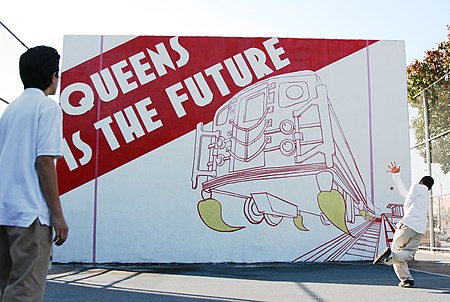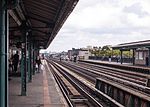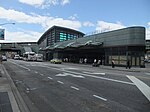Queens is the Future

Queens is the Future is a mural created in 2007 by married artists Eve Biddle and Joshua Frankel. It is located on a handball court in the schoolyard of I.S. 145, a public middle school in Jackson Heights, Queens. The mural originally depicted a subway car blasting off of its tracks as though powered by rocket fuel, with the words “Queens is the Future” painted in the upper left corner. It quickly became an iconic image of the borough, inspiring the Municipal Art Society to name their walking tour of neighborhood after the work, as well as appearing in Sports Illustrated, Time Out New York, and a short documentary about the rise of Bronx and Queens Rep. Alexandria Ocasio-Cortez.In January 2015, without consulting the original artists, Sony Pictures altered the mural, inserting Spider-Man into the image, to promote the release of the film The Amazing Spider-Man 2.The mural was restored in 2022.
Excerpt from the Wikipedia article Queens is the Future (License: CC BY-SA 3.0, Authors, Images).Queens is the Future
Northern Boulevard, New York Queens County
Geographical coordinates (GPS) Address Nearby Places Show on map
Geographical coordinates (GPS)
| Latitude | Longitude |
|---|---|
| N 40.755166666667 ° | E -73.887444444444 ° |
Address
Northern Boulevard
11372 New York, Queens County
New York, United States
Open on Google Maps








